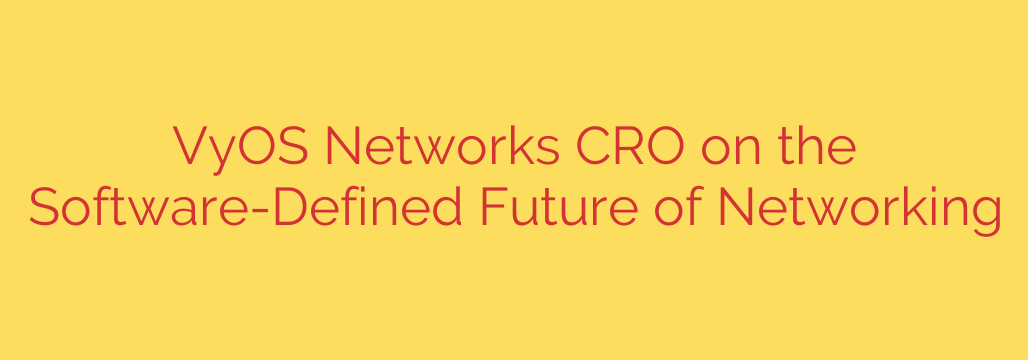
Rethinking Your Network: The Inevitable Rise of Software-Defined Solutions
For decades, building and managing a business network meant one thing: expensive, proprietary hardware. Routers, switches, and firewalls from major vendors were the bedrock of IT infrastructure, often leading to vendor lock-in, complex management, and sky-high costs. But the ground is shifting. The modern demands of cloud computing, remote work, and edge devices are pushing traditional networking to its breaking point. The future is not built on specialized boxes but on intelligent, flexible software.
This evolution is known as Software-Defined Networking (SDN), a transformative approach that decouples network control from the physical hardware. Instead of configuring individual devices manually, SDN allows for centralized management and automation, turning the network into a programmable, agile resource. This isn’t just a minor upgrade; it’s a fundamental paradigm shift that empowers organizations to build networks that are more resilient, secure, and cost-effective than ever before.
The Core Benefits of a Software-Defined Approach
Moving away from a hardware-centric model unlocks significant advantages for businesses of all sizes. The ability to run networking functions on standard, off-the-shelf hardware immediately changes the economic equation, but the benefits go far beyond the initial purchase price.
Key advantages include:
- Massive Cost Savings: By eliminating the need for expensive, specialized hardware, organizations can dramatically reduce their capital expenditures. Open-source network operating systems allow businesses to leverage commodity servers and virtual machines, directing budgets toward innovation instead of proprietary equipment.
- Unprecedented Agility and Speed: In a software-defined environment, deploying a new router, firewall, or VPN gateway can be done in minutes, not weeks. Networks can be spun up, reconfigured, and scaled on demand through automated scripts and centralized controllers, allowing businesses to respond instantly to new opportunities or challenges.
- Freedom from Vendor Lock-In: Traditional networking often forces you into a single vendor’s ecosystem, limiting your options and exposing you to their pricing and product roadmaps. A software-based approach provides freedom. It allows you to mix and match hardware and software components, choosing the best tools for the job without being tied to a single manufacturer.
- Centralized Management and Visibility: Instead of logging into dozens or hundreds of individual devices, SDN provides a single pane of glass to manage and monitor the entire network. This simplifies administration, reduces the chance of human error, and provides a holistic view of network performance and security.
Where Software-Defined Networking Makes an Impact
The flexibility of SDN makes it a powerful tool for solving modern IT challenges. It’s not just a solution for massive data centers; its principles are being applied across the entire digital landscape to create more efficient and secure infrastructure.
Common real-world applications include:
- Cloud and Multi-Cloud Environments: SDN is essential for connecting and securing workloads across different cloud providers (like AWS, Azure, and Google Cloud) and on-premises data centers. It allows for the creation of seamless, secure virtual networks that span multiple environments.
- Edge Computing: As more data processing moves to the “edge”—closer to where it’s generated by IoT devices and users—the need for intelligent, lightweight, and automated networking solutions grows. Software-defined routers and firewalls are perfect for deployment at thousands of remote sites, managed centrally from the core.
- SD-WAN (Software-Defined Wide Area Network): For businesses with multiple branch offices, SD-WAN uses software to intelligently route traffic over a variety of connections (MPLS, broadband, LTE). This optimizes application performance, reduces reliance on expensive private lines, and simplifies branch office connectivity.
- Enhanced Network Security: By centralizing control, SDN makes it easier to implement and enforce consistent security policies. Micro-segmentation, for example, allows you to create isolated network zones to prevent the lateral movement of threats. Security rules can be automated and applied dynamically as the network changes.
Actionable Steps for a Secure, Software-Defined Future
Transitioning to a software-defined model requires a strategic approach, especially regarding security. As networks become more dynamic and programmable, it’s crucial to build security into the foundation of your architecture.
Here are essential security tips to keep in mind:
- Embrace a Zero Trust Model: In a software-defined world, you should never assume trust based on network location. Authenticate and authorize every connection, whether it originates inside or outside your perimeter.
- Automate Policy Enforcement: Use the power of software to automate the application of security rules. When a new virtual machine is created or a user connects from a new location, security policies should be applied instantly and consistently without manual intervention.
- Prioritize Visibility and Monitoring: Centralized management offers a golden opportunity for comprehensive monitoring. Implement tools that provide deep visibility into traffic flows, detect anomalies, and log all network activity for security audits and incident response.
- Secure the Control Plane: The centralized controller in an SDN environment is the “brain” of the network. Protecting it is paramount. Ensure it is hardened, access is tightly restricted, and all communications between the controller and network devices are encrypted.
The era of rigid, hardware-defined networking is coming to a close. For organizations looking to compete in a fast-paced digital world, embracing a software-defined strategy is no longer an option—it’s a necessity. By prioritizing flexibility, automation, and security, businesses can build the agile and resilient networks required to thrive today and in the future.
Source: https://datacenternews.asia/story/exclusive-vyos-networks-cro-on-why-networks-are-becoming-software








